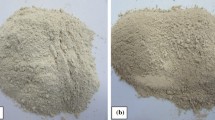Abstract
Technological tests of Malinovetskoe kaolins have shown that mixtures with these kaolins in the binder give chamotte refractories with a porosity of 19–24%. Denser articles can be produced with the addition of sintering clays such as Novoraiskoe or Nizhne-Uvel’skoe, by the method of joint milling, or with an additive of finely milled chamotte
Similar content being viewed by others
References
V. V. Goncharov,Refractory Clays of the Borovichsko-Lyubytinskoe Region [in Russian], Metallurgizdat, Moscow (1952).
T. I. Yakovleva and N. I. Smirnova, “Refractory clays of the Malinovetskoe deposit,” in:Production of Refractories, A Reference Book, MFM USSR, No. 6(49) [in Russian], VIO, Leningrad (1977), pp. 12–23.
A. K. Karklit, F. S. Kaplan, G. M. Katorgin, and T. L. Derkunova, “Kaolins of the Malinovetskoe deposit,”Ogneup. Tekh. Keram., No. 5, 37–40 (1999).
Author information
Authors and Affiliations
Rights and permissions
About this article
Cite this article
Karklit, A.K., Derkunova, T.L. & Nikolaeva, G.Y. Refractories with malinovetskoe kaolins in the binder. Refract Ind Ceram 40, 347–350 (1999). https://doi.org/10.1007/BF02762585
Issue Date:
DOI: https://doi.org/10.1007/BF02762585




